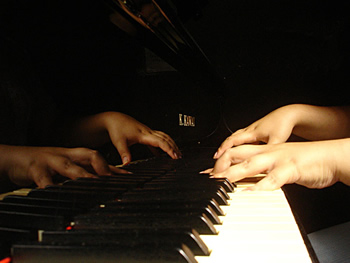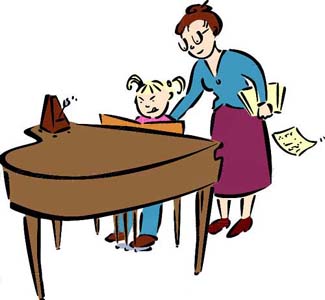
The main focus of this lesson is to instruct on how to play the simplest of chords on a keyboard while showing how to obtain them with some small amount of understanding. Hopefully, this will help the guitarist understand how chords are played on the guitar easier than using the guitar alone. It will also provide the guitarist with a quick introduction to the keyboard. By using the information provided below, the guitarist can more easily figure out what notes are being played with particular chords.
Having some small amount of musical training while I was young, I can say where things usually begin when a new student is being taught piano. It starts at middle C.
So, where is middle C? The placement of middle C on a musical staff can be researched on the personís own time. I am sure it is found in a number of other places on the Internet. This lesson will show how to finger all the major chords, minor chords, and dominant 7th chords, hopefully without overwhelming you with music theory. So, let us have a look at a diagram of the some keyboards.


Note that middle C is off centre and not the middle note in the keyboard. This is because this and many other keyboards as well as full-size pianos are not symmetrical about middle C. The reasoning behind that is for some other topic of research that goes into the development of music as a whole. What is important is that you can learn how to locate middle C with a little practice.
Other common sizes for keyboards are 73 keys, 76 keys, and 88 keys. These can be seen below in Figure 3, Figure 4 and Figure 5, respectively.



While middle C is not usually (see Figure 3) in the middle of the keyboard, it is almost there. It makes a practical place to start in terms of range of musical sounds. It also makes a very good place to start when studying music theory.
Teaching your child to play a keyboard can be done in several ways
of doing it Ė you can find them a teacher, look up how to play online
or allow the child to learn to play by ear. This helps the brain to
develop properly and is a healthy skill. The necessary things for
playing keyboard are proper positioning of the childís hands (otherwise
bone injury could occur), proper posture, the ability to read music and
the ability to sight-read, ie play a piece without practicing it prior.
There are several skills your child will need to learn when playing
keyboard or any other musical instrument. All of these help the childís
brain to develop in creativity and intellect, and are critical to
learning music. The keyboard takes a long time to really gain skill in,
so be sure that your childís up to the commitment.
Basic
scales are the next thing for a child to learn on keyboard. C scale is
the most basic of these, so show the child where C is Ė itís the key
just to the left of a series of two black keys. Then show them how to
progress up the scale with the right thumb, index finger, middle
finger, and then carry on this way until the next octave. This is a
full major C scale.
 Learning
to play a scale one-handed is easiest learned this way, and itíll teach
the child dexterity in the fingers. Sheet music shouldnít be bothered
with this early in the musical education of a child Ė instead, try to
encourage them to play a theme for a favourite TV show on the keyboard,
like the basic Spongebob melody or anything else they happen to like to
watch. Mainly, itís most important to help them figure out how to play
the melody by simply listening which is a skill that everyone should
try to develop at some point.
Learning
to play a scale one-handed is easiest learned this way, and itíll teach
the child dexterity in the fingers. Sheet music shouldnít be bothered
with this early in the musical education of a child Ė instead, try to
encourage them to play a theme for a favourite TV show on the keyboard,
like the basic Spongebob melody or anything else they happen to like to
watch. Mainly, itís most important to help them figure out how to play
the melody by simply listening which is a skill that everyone should
try to develop at some point.
You can show the methods of reading sheet music later on, but itís best to go more slowly with this part. Sometimes it can be complicated or confusing to a child, but as children are quick to learn they can grasp the basics easily enough. Children can then learn to play along with and read music at the same time, and this can provide a healthy dose of accomplishment from learning a new skill. Especially with keyboard, learning any kind of musical instrument is a mentally stimulating activity for childrenís mental development.
3.Finding a Keyboard Teacher
You can also take courses at a local college or university in
playing the keyboard. You can look into signing up for one of these,
and youíll be getting a very solid background in music education
because the teachers are professional, and have learned to play their
instrument of choice. Know about the schoolís admissions policy,
because you will technically be a student albeit even if itís not in
the normal sense.
Look in the Google for the music school. Always, it is preferred to learn music under the guidance of a teacher. So that, you can be guided in the right way.
 Maybe
there arenít any available private tutors. There are still ways to
learn though, so donít give up. Look in local music stores. Usually,
there will be people there whoíll offer lessons as part of their job.
Like you would otherwise get to know the person, their expected pay,
your meeting times, etc. Youíre pretty much guaranteed to get a quality
musical education because music stores only allow people with a musical
background to teach music lessons.
Maybe
there arenít any available private tutors. There are still ways to
learn though, so donít give up. Look in local music stores. Usually,
there will be people there whoíll offer lessons as part of their job.
Like you would otherwise get to know the person, their expected pay,
your meeting times, etc. Youíre pretty much guaranteed to get a quality
musical education because music stores only allow people with a musical
background to teach music lessons.
These are all
different methods to seek out a private keyboard teacher. Likely youíll
fare the best if you look at a music store or university, but no matter
what you choose, thereís going to be a way to learn how to play
keyboard from an experienced teacher in your area. All it takes is some
resourcefulness on your part and knowing where to look for instruction.
You can also go to your local church and ask about lessons there.
Usually, music lessons often are held in churches by the church choir
or instrumental director.
As long as you keep looking for instruction in playing the keyboard, youíll find it because there are more people interested in it that you think.